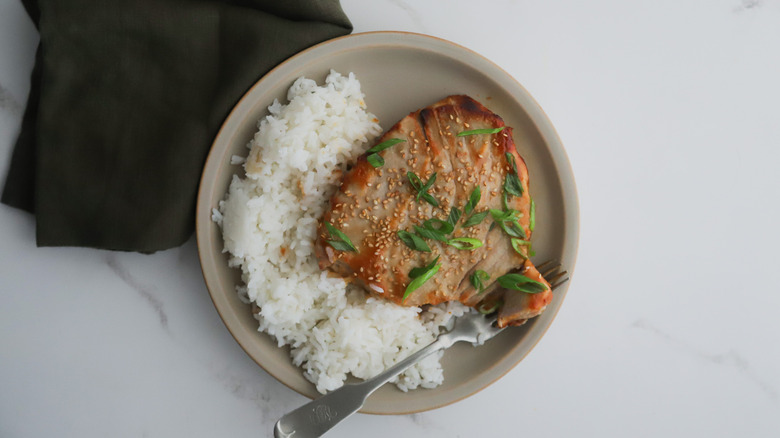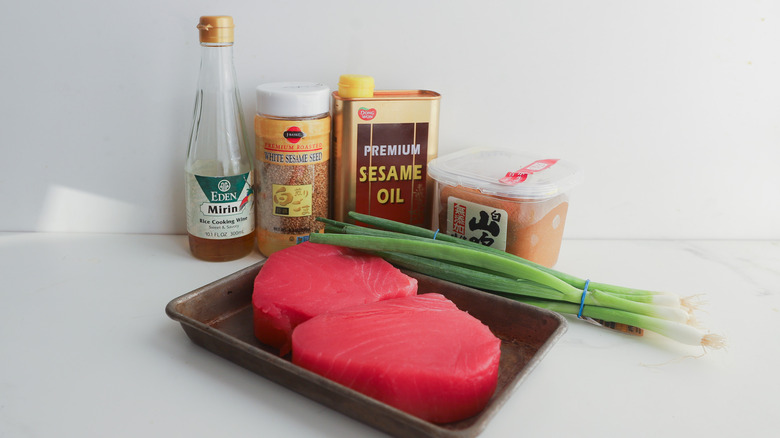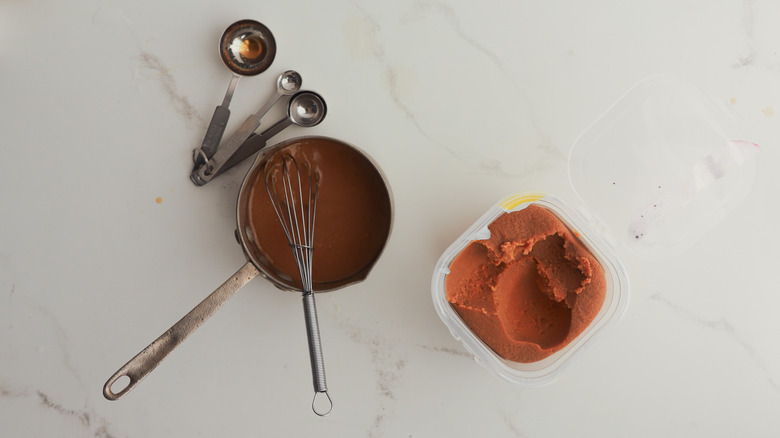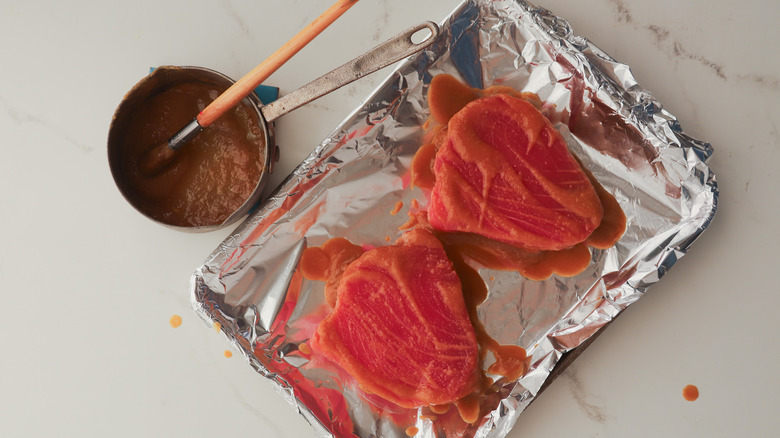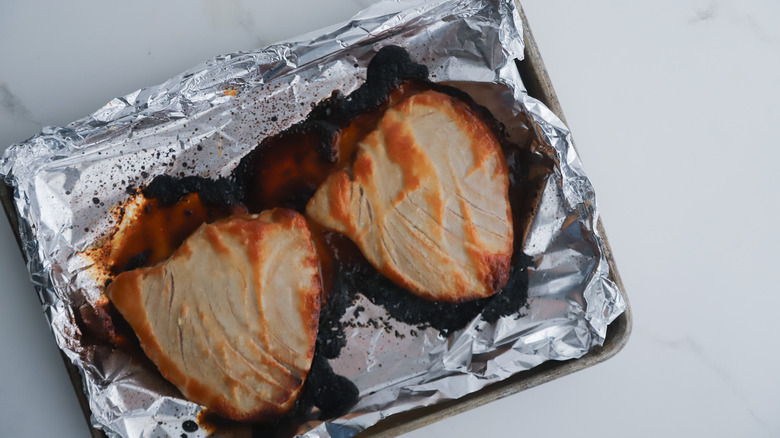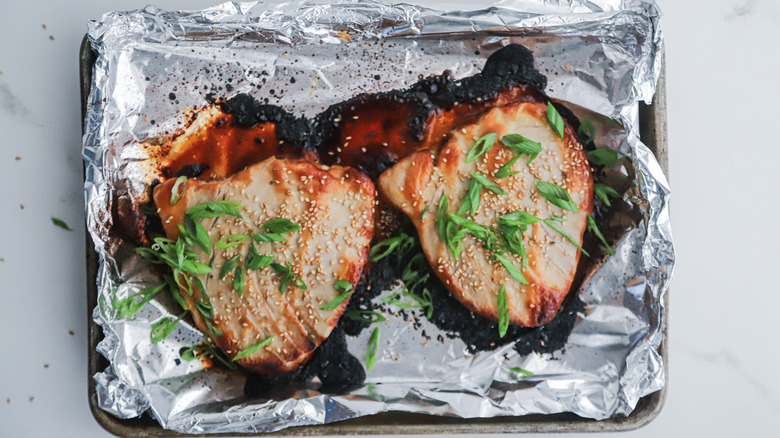Baked Tuna Steak With Sesame-Miso Glaze Recipe
For many, the notion of baked tuna steaks might conjure up images of a basic, uninspiring, meal. It's true that oven-baking is a straightforward, fuss-free method that removes the need for expert grilling or skillet skills. However, it can often lead to a rather unremarkable result when cooking fish. Inspired by the famous Nobu miso-glazed black cod, this recipe utilizes the genius of using a umami-rich glaze to add flavor and texture to the exterior of the tuna steaks.
Recipe developer Taylor Murray brings us a restaurant-quality dish that's simple and easy to make at home. "This is one of my go-to weeknight meals when I need a satisfying dinner but I just can't be bothered to do much," says Murray.
Bursting with contrasting flavors and textures, and a satisfying umami depth from the miso, this recipe brings a thrill to every bite. Pair it with white rice, as the recipe suggests, or create your own delightful meal with whichever side you choose.
Gather the ingredients for baked tuna steak with sesame-miso glaze
The ingredients for this dish are fairly simple and, if you have any experience cooking Asian dishes, you might already have them in your pantry. The glaze for the fish is a mixture of miso, sesame oil, and mirin.
Miso is a traditional Japanese product made by fermenting soybeans with salt. It's a culinary staple in Japan and comes in various types, including white (shiro), red (aka), and mixed (awase) — each offering a different depth and complexity of flavor. It is rich in umami and can offer a pleasant saltiness with notes of caramel.
The sesame oil adds notes of toasty nuttiness. Always opt for toasted sesame oil for this recipe, as the flavor has been more fully developed.
Mirin is a sweet rice wine that's a staple in Japanese cooking. It's similar to sake, but has a lower alcohol content and higher sugar content, giving it a distinct sweet flavor. Mirin is typically used for cooking rather than drinking. It adds a nice sweetness to the glaze without adding any actual sugar.
The tuna itself can be found at many grocery stores. If you can, look for fresh steaks that are bright red in color. Avoid any with darker red tones as that can indicate a cut that has some of the bloodline, which can add an unpleasant taste.
To top everything off, you'll finish the dish with some toasted sesame seeds and a bit of sliced scallion. The seeds at a nice crunchy texture and the scallion adds a nice pop of greenery.
Make the glaze
In a small pot, whisk together the miso, sesame oil, mirin, and 1 tablespoon water until smooth. Bring it to a simmer, then remove from heat. Cooking the sauce before applying it to the fish accomplishes a few things. First, this can help the miso dissolve into the rest of the sauce. This process also helps the ingredients blend together more readily. Finally, bringing the sauce to a simmer can help concentrate the sweetness in the mirin and cook off any remaining alcohol, so that it can accomplish turning the sauce into a glaze.
Coat the fish
The process of glazing the tuna steaks is a delicate and important step in this recipe, but it's much easier than you might think. Start by making sure your tuna steaks are clean, dry, and laid out on a clean, flat surface — a chopping board or baking sheet will work just fine. Have your delicious miso glaze ready in a bowl.
Now, for the fun part. You'll need a good-quality pastry brush; if you don't have one, a clean, unused paintbrush or even the back of a spoon can do in a pinch. Dip it into your glaze, then begin brushing the glaze over the surface of each tuna steak. Make sure to coat every inch, paying close attention to the edges and any natural crevices in the fish, where you can layer in extra flavor.
The aim here is to get a good, even layer of glaze all over the steaks, which will give your tuna that beautiful, glossy finish and robust flavor in the final result. You should see the steaks start to take on a rich, appetizing color from the glaze, a tantalizing preview of the wonderful meal to come. Take your time with this step; it's a bit of culinary self-care, the kind of simple kitchen task that's quietly satisfying. Once your tuna steaks are thoroughly coated, they're ready to go into the oven and transform into something truly special.
Bake your tuna steaks
Start by preheating your oven. Setting the temperature to 400 F allows the tuna steaks to cook evenly and quickly, giving them a beautiful texture without drying them out. While the oven is preheating, prepare the sheet tray. A foil-lined sheet tray is not just recommended for convenience, but it's an essential part of achieving the perfect cook. The foil helps evenly distribute the oven's heat and makes cleanup a breeze afterward. Simply tear off a sheet of foil large enough to comfortably hold your tuna steaks and gently press it onto the tray.
Once the oven is hot, arrange the miso-glazed steaks carefully on your prepared tray. Space them evenly apart to ensure proper heat circulation. Slide the tray into the oven and set your timer. For those who prefer their tuna medium-well, a cooking time of approximately 15–16 minutes is ideal. This allows the steaks to cook through while still retaining some of their natural moistness and flakiness. However, always remember that oven temperatures can vary, so it's a good idea to start checking a bit earlier.
Plate and garnish
Remove the tray from the oven and reveal your beautifully glazed, perfectly cooked tuna steaks. Allow them a moment to cool slightly, absorbing the aromas that fill your kitchen. The next stage of this recipe involves adding an extra layer of flavor and texture. Reach for your sesame seeds and sprinkle them over the still-warm tuna steaks. They should adhere to the sticky glaze, providing a lovely contrast with their subtle crunch and nutty taste. Add the finely chopped scallions to bring a pop of color and a hint of freshness to the dish, cutting through the rich miso glaze with their mild onion-like flavor.
Finally, it's time to complete this meal with the perfect accompaniment, steamed white rice. The neutral canvas of the rice is an ideal partner for the strong, umami flavors of the tuna, absorbing any extra glaze and providing a soft, comforting texture. While steamed white rice is a classic accompaniment to miso-glazed tuna steaks, there are plenty of other exciting sides to consider. Japanese soba or udon noodles, for instance, tossed in a light peanut sauce, would make a delicious pairing.
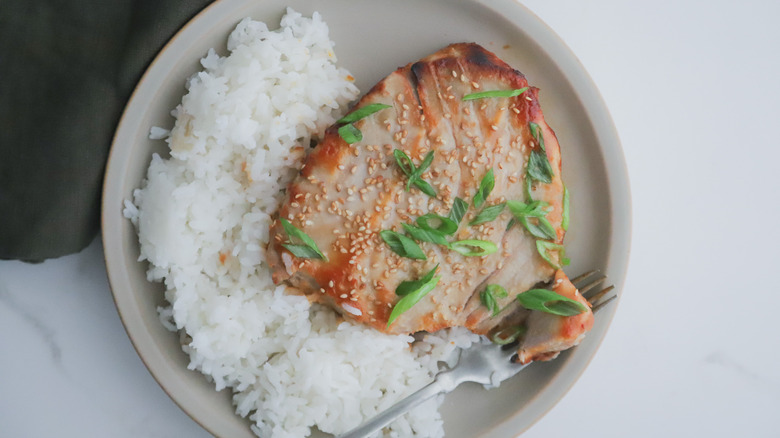
- 1/4 cup miso paste
- 1 tablespoon sesame oil
- 1 tablespoon mirin
- 1 tablespoon water
- 2 8-ounce tuna steaks
- 2 teaspoons toasted sesame seeds
- 2 scallions, thinly sliced
- In a small pot, whisk together miso, sesame oil, mirin, and water.
- Bring the pot to a simmer, then remove from heat.
- Use a pastry brush to brush the tuna steaks all over with the glaze.
- Heat an oven to 400 F. Place the steaks on a foil-lined sheet tray and bake to the desired doneness, 15–16 minutes for medium well.
- Remove from oven and let cool slightly. Sprinkle with sesame seeds and scallions. Serve with steamed white rice.
| Calories per Serving | 407 |
| Total Fat | 11.5 g |
| Saturated Fat | 1.9 g |
| Trans Fat | 0.0 g |
| Cholesterol | 88.5 mg |
| Total Carbohydrates | 10.8 g |
| Dietary Fiber | 2.6 g |
| Total Sugars | 2.5 g |
| Sodium | 1,387.2 mg |
| Protein | 60.6 g |
